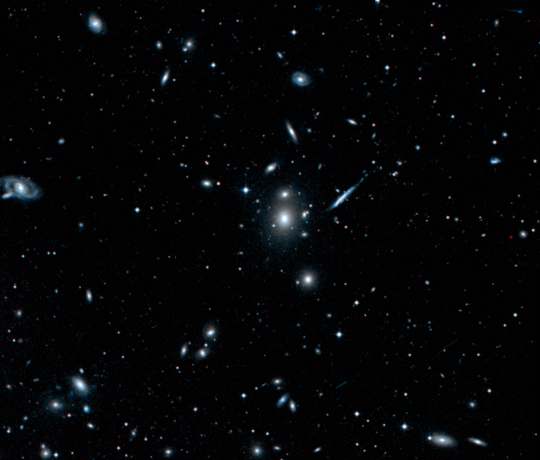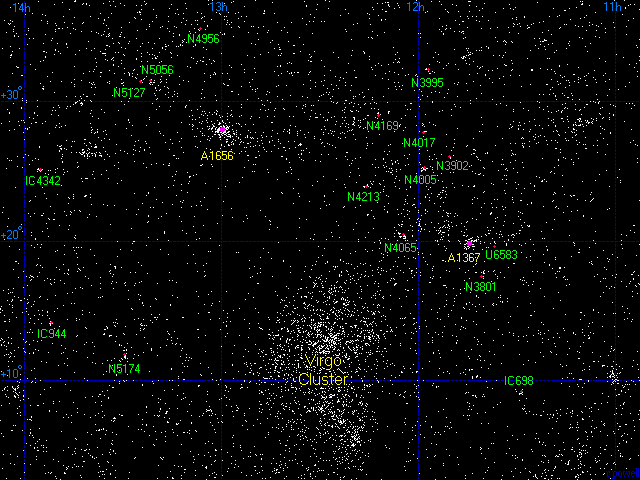
The Coma supercluster is a very famous supercluster. This map below is a plot of the brightest galaxies (from the Principal Galaxies Catalogue) in this region of the sky. Dominating this picture is the Virgo cluster - the nearest rich cluster in the universe and the dominant cluster in the the Virgo supercluster. Above the Virgo cluster and much further away are two much richer clusters - A1367 and A1656. These are the two main clusters in the Coma supercluster.

Below is a list of the major clusters in the Coma Supercluster. The supercluster contains only two major clusters of galaxies. They are both very rich clusters with a richness class of 2, although A1656 is larger and richer than A1367.
1 2 3 4 5 6 7
Abell Equatorial Redshift Distance Rich Notes
Number Coordinates z Mly
RA Dec
A1367 11 44.5 +19 50 .0208 290 2 Leo cluster
A1656 12 59.8 +27 59 .0219 305 2 Coma cluster
|
Below is a list of some of the other major groups in the vicinity of the Coma supercluster. Some of these groups are foreground groups that lie between the Virgo and Coma superclusters. These two superclusters are connected to each other through some minor walls of galaxies.
1 2 3 4 5 6 7
Group Equatorial Redshift Distance Rich Notes
Name Coordinates z Mly
RA Dec
IC 698 11 28.7 +09 04 .0210 290
UGC6583 11 36.9 +19 58 .0214 295 A1367-West
NGC3801 11 40.9 +17 27 .0108 150
NGC3902 11 50.5 +25 59 .0120 165
NGC3995 11 57.0 +32 19 .0106 145
NGC4005 11 58.2 +25 11 .0153 210
NGC4017 11 58.4 +27 46 .0114 160
NGC4065 12 04.5 +20 18 .0235 325
NGC4169 12 12.1 +29 07 .0127 175
NGC4213 12 15.8 +23 58 .0233 320
NGC4956 13 06.4 +35 14 .0160 220
NGC5056 13 21.7 +31 35 .0214 295 A1656-East
NGC5127 13 24.6 +31 30 .0162 225
NGC5174 13 29.5 +11 44 .0232 320
IC 944 13 52.0 +14 05 .0234 325
IC4342 13 55.4 +25 05 .0293 405
|
Column 1: The name/number of the cluster or group.
Column 2: The Right Ascension for epoch 2000.
Column 3: The Declination for epoch 2000.
Column 4: The redshift of the cluster.
Column 5: The distance in millions of light years assuming H=70km/s/Mpc.
Column 6: The 'richness' class of the cluster (for Abell clusters only).
Column 7: Additional names and notes.
References:
Abell G, Corwin H, Olowin R, (1989), A catalogue of Rich Clusters of Galaxies,
Astrophys J Supp, 70, 1.
Struble M, Rood H, (1999), A compilation of redshifts and velocity dispersions for
ACO clusters, Astrophys J, 125, 35.
Garcia A, (1993), General study of group membership. II. Determination of nearby groups.
Astron Astrophys Supp, 100, 47.
Giuricin G, Marinoni C, Ceriani L, Pisani A, (2000), Nearby optical galaxies: selection
of the sample and identification of groups. Astrophys J, 543, 178.
Geller M, Huchra J, (1983), Groups of Galaxies. III. The CfA Survey.
Astrophys J Supp, 52, 61.
White R, Bliton M, Bhavsar S, Bornmann P, Burns J, Ledlow M, Loken C, (1999), Catalog
of nearby poor clusters of galaxies. Astron J, 118, 2014.
The Coma cluster (A1656) is one of the most famous clusters of galaxies. It has received a huge amount of scientific research. This is partly because it is a very rich cluster containing thousands of galaxies. Another reason is that the Coma cluster lies a long way from the plane of our Galaxy (unlike the Perseus cluster, or the A3627 cluster) and it is largely unobscured by any gas and dust or any foreground stars.
The Coma cluster is dominated by two enormous elliptical galaxies. These are NGC4874 (right) and NGC4889 (left), they both have a diameter larger than 250 000 light years and they are much more massive than any galaxies in the Virgo supercluster. There is also one obvious foreground star in this image, HD112887, an eighth magnitude star 265 light years away - less than one millionth of the distance to the Coma cluster.
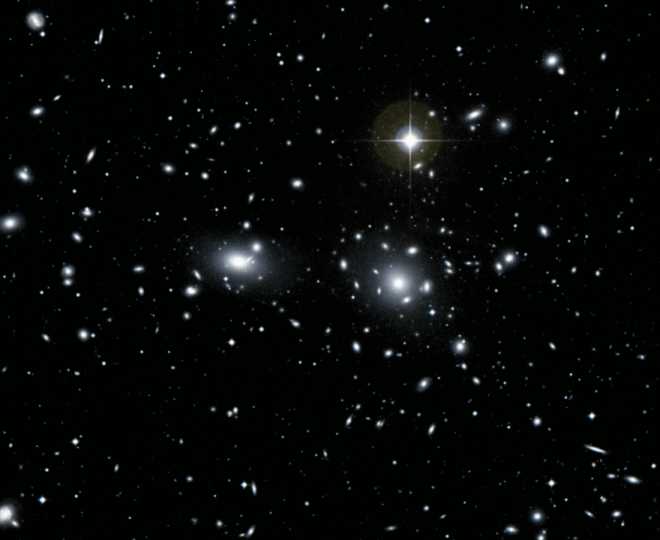
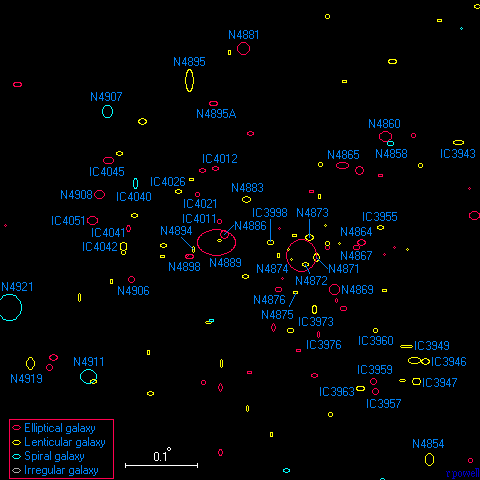
This is a map of the central area of the Coma cluster. This map shows the positions of 118 of the brightest galaxies in the core of this cluster. It is immediately obvious that there are very few spiral galaxies, and no bright irregular galaxies. Nearly all of the galaxies here are elliptical and lenticular galaxies. One of the most popular theories on how elliptical and lenticular galaxies form is that they form from the merger of smaller galaxies. In the dense enviroment of the Coma cluster there have probably been many galaxy mergers over billions of years, and the result is a cluster with a very low number of spiral and irregular galaxies.
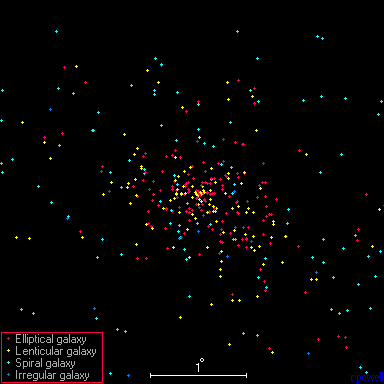
This is a second map of the Coma cluster. This map has a width of four degrees (the previous map had a width of two-thirds of a degree). The blue points show the spiral galaxies and irregular galaxies, they are clearly more numerous in the outer parts of the cluster. This is very common in very rich clusters - the elliptical/lenticular galaxies are usually found in the centre, and the spiral/irregular galaxies are usually found in the outer regions.
The Coma supercluster has played a very important role in our knowledge of the structure of the universe. It was one of the first superclusters discovered. At the same time as Mihkel Jõeveer and Jaan Einasto in Estonia were suggesting that the universe was filled with superclusters and voids (see the page on the Perseus-Pisces supercluster), Stephen Gregory and Laird Thompson in the USA were also accumulating similar evidence. In 1978 they submitted a paper to the Astrophysical Journal entitled The Coma/A1367 supercluster and its environs. The paper contains a map of the supercluster showing how the two main clusters are contained within a larger supercluster. Laird Thompson has written a web page explaining about their Discovery of Superclusters and Voids.
In 1986, Valérie de Lapparent, Margaret Geller and John Huchra produced probably the most famous map of the structure of the universe ever made. In a paper called A slice of the universe they produced a famous map of the Coma supercluster. This picture was published in newspapers and magazines around the world because it showed the Coma cluster (looking like a strange stick-man figure) at the centre of a Great Wall of galaxies with a length of about six hundred million light years. It confirmed that the galaxies in the universe are arranged in sheets and walls surrounding large nearly-empty voids.
Since 1986, The Center for Astrophysics (CfA) at Harvard University has continued surveying this region of the sky. John Huchra has written a web page explaining about the survey.
The Coma cluster (A1656) has also played a very important role in our understanding of the universe. William Herschel discovered this cluster in 1785. In 1933, Fritz Zwicky submitted a paper to a Swiss Journal (Helvetica Physica Acta 6, 110) with the title: Die Rotverschiebung von extragalaktischen Nebeln, (The redshift of extragalactic nebulae). By studying the velocities of the galaxies in the cluster he showed that the cluster contained much more dark, invisible matter than visible matter. He later summarised his results in a paper (mainly in section 3) published in the Astrophysical Journal in 1937. Although he was correct, his research was ignored by other astronomers until the 1970's when astronomers began to realise that most of the matter in the universe must be of a dark, unseen type. The precise nature of this dark matter is still a mystery but it probably consists of enormous amounts of tiny subatomic particles which are present throughout the entire universe.
A huge amount of scientific research is directed at the Coma cluster. Only the Virgo cluster has received a similar amount of attention. In the five years from 1997 to 2001 approximately 125 papers were published about the Coma cluster, (almost identical to the number published about the Virgo cluster in the same period).
The Leo cluster (A1367) is also a very rich cluster, but because it is not as rich as the Coma cluster it is not studied as much. (Between 1997 and 2001 approximately 11 papers were written about this cluster).
Below is a picture of part of the Leo cluster. It is not as famous as the Coma cluster because it is slightly smaller and it contains fewer galaxies. The bright elliptical galaxy in the centre is NGC 3842 and the large spiral galaxy on the left is NGC 3861.
